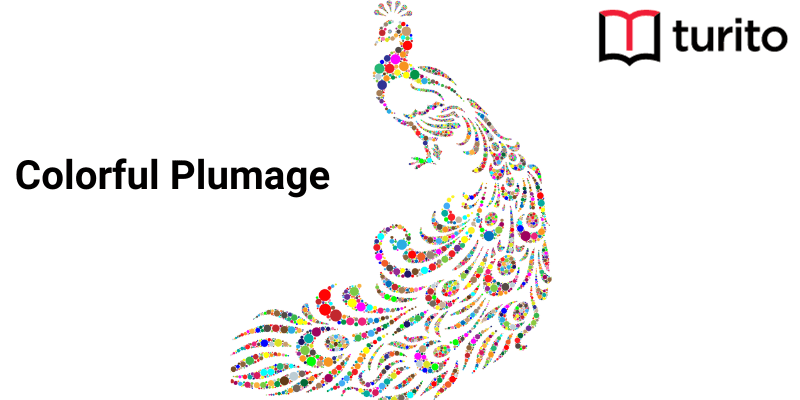Key Concepts
- Plumage
- Pigments
- Natal Plumage
- Nuptial Plumage
- Juvenile Plumage
- Subadult Plumage
- Albinism
Introduction
The pattern, color, and arrangement of feathers that cover a bird are referred to as plumage.
Plumology is the study of feathers.
For scientists, this richness and diversity have long been a surprise, not only between species but even within various populations of the same bird, from the brilliant and eye-catching colors of macaws to the exquisite design of peacock tails.

Colorful feathers can be used for a variety of purposes:
- They’re meant to attract potential partners.
- Birds use colors and patterns to identify their own species.
- Colors can help birds camouflage themselves from predators.
- Colors are utilized to draw attention (i.e., courtship: a behavior that results in mating and eventual reproduction).
- When trying to divert predators, colors are employed to draw attention.

Interesting fact:
Predators are more likely to target odd-colored birds in a species. In general, predators will try to grab a bird that stands out more often than birds that fit in.

Explanation
Recent research has revealed where the complex designs of plumage come from, and to what extent they are inscribed in the genes or are influenced by external influences.
Carotenoids, melanin, and porphyrins are the three pigment groups that give birds their color.
Foods That Change The Color Of Birds
Carotenoids:
Carotenoids are plant-derived substances (only made by plants and algae), therefore, if a bird’s feathers contain them, it is because it ate plants or animals that had previously consumed them.
Flamingos receive their pink hue from the food they eat.
Carotenoids are responsible for carrots’ orange color and ripe tomatoes’ red color.
They are also found in brine shrimp’s diet of microscopic algae. The flamingo’s body metabolizes the pigments in algae and brine shrimp, turning its feathers pink.


Melanin:
Unlike carotenoids, animals (including birds) can make their own pigments: melanin, which provides various shades of black, brown, grey, earth, etc. They are the same chemicals that give humans their various skin tones and colors.
The genuine owl and the golden eagle are two examples of birds whose coloring is due to melanin.
Melanocytes, which are specialized cells, produce melanin. It is the only genetically programmed plumage coloration system that is controlled directly at the cellular level.


Porphyrins:
Many gallinaceous species (such as the peacock) and pigeons have brilliant pinks, reds, browns, and greens due to porphyrins.
Psittacofulvin and turacin are even more exclusive pigments: the former is only found in the order Psittaciformes (tropical birds like parrots, cockatoos, and macaws), while the latter is only found in turacos.
The bright greens and reds that define these birds are due to both pigments.
The most exotic birds alter the structure of carotenoids, and thus their color, in order to produce pigments such as porphyrins, psittacofulvins, and turacins.
As a result, the presence and influence of these unique pigments are dependent on the availability of carotenoid-rich meals.
These pigments (pinks, reds, browns, and greens) are distinctive for three reasons:
Their bright and strong colors, the fact that they are only found in a few groups of birds, and the fact that these birds synthesize them using particular mechanisms.


Some birds have different plumages throughout the year, while others have the same plumage year after year.
While plumage is often the most straightforward way to identify birds, it can be perplexing when they change plumages or adopt color variations that are unfamiliar to birders.
Many bird species go through a variety of basic plumages throughout the year.

Natal plumage
This refers to the plumage of very young birds that are only a few days or weeks old.
Precocial species, such as ducks, have this plumage from birth, but altricial species, such as passerines, sprout these fluffy feathers in their first few days of life.
The color of these feathers is usually basic, and they function to insulate the young one and camouflage.

Juvenile plumage
This is the coloration that young birds exhibit for the first few weeks or months of their lives, usually in the summer and early fall after they have hatched.
This plumage is still fairly plain to help with hiding, but it may start to display mature colors and patterning.
Spotting, streaks, and other characteristics are common in juvenile plumage, which helps keep birds hidden.
Subadult plumage:
During adolescence, birds that take several years to mature may display various subadult plumages.
This is notably prevalent in raptors and gulls, both of which can take up to three years to mature.
Immature birds have less distinct plumage until they reach adulthood when their plumage begins to match the adult plumage more closely.

Basic plumage
This is the non-breeding plumage of a mature bird. For many species, this is the plumage that the birds wear for most of the year, and it may be more concealed than during the mating season with duller colors and fewer prominent markings.
This is also known as winter plumage or non-breeding plumage. Because males’ breeding plumage is “eclipsed” by this bland coloration for a short time in some species, particularly ducks, it is known as eclipse plumage.

Breeding plumage
Many bird species display their most dazzling, colorful plumage during the courtship season when they are attempting to attract mates. Males produce striking breeding plumage, which can include distinctive colors or shapes such as lengthy streamers.
This is also known as nuptial plumage, spring plumage, or alternative plumage. Breeding plumage may be worn for the full spring and summer in certain species, while it may only be worn for a few weeks in others.

Birds can display a variety of odd or abnormal variations in addition to their standard plumages.
Leucism:
A hereditary disorder that impairs feather pigmentation, resulting in pale or white feathers in spots or throughout the bird’s plumage.

Melanism:
A hereditary disorder that affects feather pigmentation, resulting in feathers that are excessively dark due to an excess of dark melanin pigments.

Albinism:
A hereditary disorder characterized by a complete lack of pigmentation and resulting in pale or white all-over plumage, as well as red or pink eyes, legs, and feet.


Baldness:
A condition in which a bird’s head feathers or other patches are removed during a molt or as a result of injury or disease.

Hybrid:
A genetically mixed bird with unclear plumage that may have colorations and markings from two or more species.

Morph:
A bird with a rare but not unheard-of plumage variation, such as very light or very black plumage, which is commonly a sign of leucism or melanism. Some species, such as the red-tailed hawk, have multiple color variants that can be distinguished.

A bird’s feathers will ultimately become damaged and worn, regardless of its age or hue, and it will be necessary to grow new ones.
Molting is the process of regrowing feathers, and birds in molt may have mottled plumage that reflects both their old and new plumages.
As their new feathers sprout, these birds may appear scruffy or ragged, with uneven feather tufts or bald patches. The absence of feathers on the wings and tail may also signal that the bird is in the process of molting.



Summary
- The pattern, color, and arrangement of feathers that cover a bird are referred to as
plumage. - Carotenoids are plant-derived substances (only made by plants and algae), therefore, if a
bird’s feathers contain them, it is because it ate plants or animals that had previously
consumed them. - Unlike carotenoids, animals (including birds) can make their own pigments: melanin,
which provides various shades of black, brown, grey, earth, etc. - Many gallinaceous species (such as the peacock) and pigeons have brilliant pinks, reds,
browns, and greens due to porphyrins. - Natal plumage: This refers to the plumage of very young birds that are only a few days or
weeks old. - Juvenile plumage: This is the coloration that young birds exhibit for the first few weeks or
months of their lives, usually in the summer and early fall after they have hatched. - Subadult plumage: During adolescence, birds that take several years to mature may
display various subadult plumages. - Birds can display a variety of odd or abnormal variations in addition to their standard plumages like leucism, melanism, albinism, hybrids, and morphs.
- Molting is the process of regrowing feathers, and birds in molt may have mottled plumage that reflects both their old and new plumages.

Related topics
Mutation Theory of Evolution and Types
Introduction: Cell is the basic unit of living organisms from bacteria to humans all are made up of cells, which contain a nucleus and the nucleus contain DNA Explanation: Mutations is a sudden changes in chromosomal DNA., They cover only those changes that alter the chemical structure of the gene at the molecular level. These […]
Read More >>Lamarckism: Postulates and Drawbacks
Introduction: Evolution states that distinct types of plants, animals, and other living organisms on Earth have their origin in pre-existing life forms. It is a variation in the inherited characteristics (traits) of biological populations over successive generations. These traits are the expressions of genes that are passed on from parents to offspring in the course […]
Read More >>Biodiversity: Classification of Living Organisms
Introduction to Biodiversity: Fig No.1 Biodiversity Classification Fig No.2 Different organisms The Characteristics of Living Organisms Fig No. 3 Classification Diversity in Living Organisms The Five Kingdom Classification The five kingdoms in this widely accepted classification are made up of species with similar growth and functioning characteristics. Organisms are classified into five kingdoms based on […]
Read More >>Mitochondria – The power House of a Cell
The Cell Organelles – Mitochondria Introduction: Powerhouse Of Cell Mitochondria are primarily responsible for converting nutrients into energy. They yield ATP molecules to fuel cell activities. As they do aerobic respiration, mitochondria are often referred to as the powerhouse of the cell. There are three stages of aerobic respiration. Those three stages are: Origin Of […]
Read More >>Other topics







Comments: